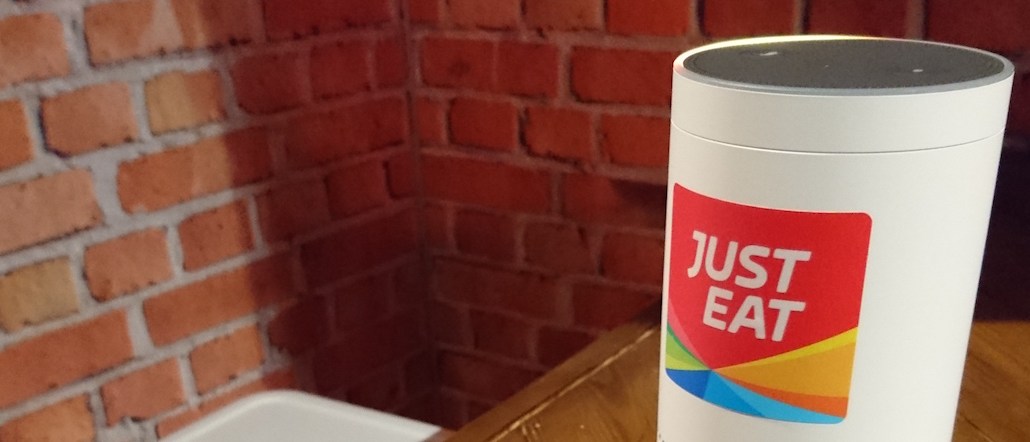

Think of a buzzword, any buzzword. Chances are, Just Eat has its hands in it.
The food-ordering giant has built a reputation as an early tech adopter. The company is, for example, a launch partner for Amazon Alexa, has a chatbot on Facebook Messenger and is testing its own delivery robots.
But there’s a fine line between an innovation and a headline-grabbing gimmick.
With UberEats and Deliveroo hot on his heels, Just Eat’s Global CMO Barnaby Dawe, who joined the company last April, sat down with Digiday to discuss how the business walks this line as it moves from being a disruptor to an incumbent.
How do you keep that startup spirit alive now you’re a large company?
Today, 45 percent of all food delivery is done online, of which we’re a large component. Just in the last 18 months, this has risen from 25 percent, which shows there’s massive headroom to grow. But although we’ve grown in scale, we haven’t lost that pioneering, disruptive spirit. When new technology comes along, we make sure we are in discussion with the big players like Microsoft and Facebook. But we’re not just doing it for fun; there has to be a practical element to it too. With things like Alexa, I think it’s about rewinding to when we started and how we can wrap ourselves around the way that people’s lives are changing.
How do you know when something’s just a gimmick?
There’s a lot of things I probably don’t see that go on inside our tech labs. Our 400-person team does tests, but when they come up with a proposition, it’s about how our business can grow and make customers’ lives friction-free, and help our restaurant partners grow and be more profitable. But even in that, there will be some things that we’ll think, “It’s on the margin, let’s try it anyway,” because that’s how we got started.
Why is it important to have all this inside the company?
Innovation is a word that’s overused, but it’s in our DNA. The technology team is the engine of our business, but it happens in lots of different places. It’s hard to say where anyone isn’t innovating, in HR, operations and marketing too. Fundamentally, it’s about how people feel when they’re in a company and how they apply that to their work. It’s about creating this energy and excitement about what we do.
What’s the biggest challenge in all this?
Ensuring across 12 markets everyone feels aligned to common goals. We operate as a small central hub with a localized structure, which means we encourage regions to behave as if it’s their own business. That’s great, but I have to make sure everyone is happy and delivering against our core goals. Prioritizing is also difficult. There are so many things we can be doing, so getting teams to think about five things that could make a difference rather than 50. But you have to be willing to try things, as you learn a lot more from failure than success.
How has your media spend changed as you’ve grown?
It’s still about what’s measurable and delivering. As markets mature, it’s about what channels are driving the right kind of behavior and customer. TV is good at driving scale quickly. In a lot of markets, the inflection point coincides with the time we go on TV. That said, we invest heavily in performance-driven media. Facebook still hits all the different parts of funnel, and they’ve taken a great interest in how we grow. We’re exploring bringing the buying journey into the platform, so there’s lots of opportunity there.
What’s next?
There’s still lots of headroom to go. We’re launching a new brand platform with an emphasis on choice: 70 percent of people on a Friday night choose to eat the same thing, so we want to convert those one-dishers into something more interesting. The technology will help, as will the campaigns around “find your flavor.”
And how will you fight off the disruptors?
Actually, competition is good; it opens up the category. It’s helping change how consumers buy food online. We’ve opened up the space, and will keep opening it up.
More in Marketing

Why the New York Times is forging connections with gamers as it diversifies its audience
The New York Times is not becoming a gaming company. But as it continues to diversify its editorial offerings for the digital era, the Times has embraced puzzle gamers as one of its core captive audiences, and it is taking ample advantage of its advantageous positioning in the space in 2024.

Why B2B marketers are advertising more like consumer brands to break through a crowded marketplace
Today’s marketing landscape is more fragmented than ever. Like consumer brands, business brands are looking to stand out in a crowded and competitive marketplace, making marketing tactics like streaming ads, influencers and humorous spots more appealing.

As draft puts WNBA in spotlight, the NBA is speeding up ballplayers’ transition to creators
The NBA’s star athletes are its greatest marketing asset.





